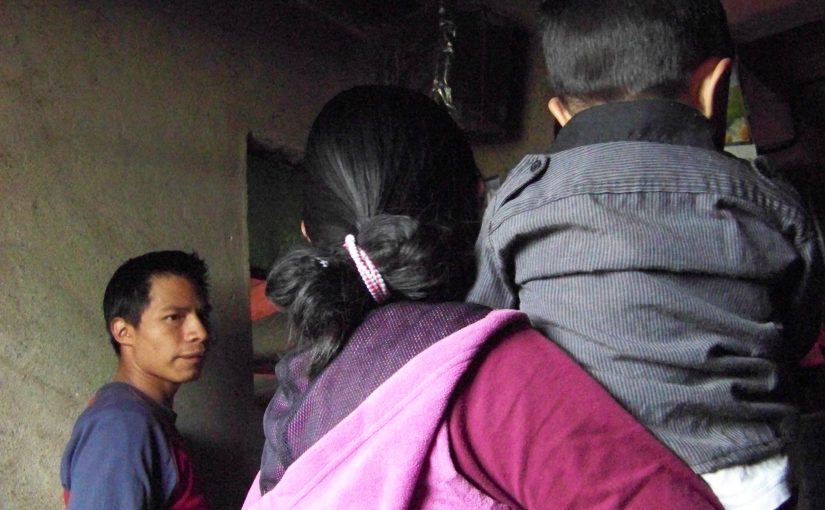Positionals form a word class in K’iche’ defined by meaning and word structure. They refer to “states” or “positions” of people or objects.
Le K’ulanem
Are taq kab’an jun k’ulanem, le utat, unan le ala chi’l le e chutiq taq tat, nan, ko’pan pa ro’ch le ali. Le achijab’ ket’uyi’ pa taq le tem, are k’u le ixoqib’ kesepi’ chwa taq le pop. K’a te k’u ri’ ketak’i’ le qatat, qanan le opanaq pa le ja k’olb’al kakiya rutzil wachaj. Kaya’taj le rutzil wachaj: konojel kexuki’k, kab’ix sin ch’ab’al. Are taq kab’antajik,kewa’lijik, ket’uyi’ chi jumul; le utat, unan le ali, kesik’in chikech le e juk’ulaj kek’uli’k are chi ket’uyi’ pa le jujun kitem (ri ojer xa kexuki’k), kaya le pixab’ chikech. Are taq katani’ le pixab’, le ali chi’l le ala, kexuku’manik keq’ax chikiwach konojel le e tat, e nan: kakitz’umaj le kiq’ab’; kab’antaj wa’ kumal, are kape chi utijowik le wa chi’l le meq’in, konojel ketak’i’k, kab’an jun sin laj ch’ab’al, are taq katijtaj le wa: kapatz le ali ruk’ le k’ak’a taq jastaq. Pa uk’isb’al, konojel le e tat, e nan kexuki’k, kakimaltyoxij kanoq, k’a te k’u ri’ ketak’i’k, kaya kan le uk’isb’al rutzil wachaj, keb’e pa ro’ch le ala, par kuk’a’m chi ub’i le ali.
When a marriage ceremony takes place, the parents and relatives of the young man arrive at the bride’s house, the men sit in chairs and the women sit upon their knees (sepi’) on straw mats. Then the relatives (lit. mothers and fathers) of those who hae arrived at the house give the ceremonial greeting. Once the greeting is given, everyone kneels, a prayer is said, and everyone stands up and sits once again. The bride’s parents invite the couple to sit in their corresponding chairs (they were kneeling before), and the ceremonial speech is given. Once the speech is given, the young man and woman, while kneeling, go around to all present and kiss their hands. Once this is done, it is time to eat. Everyone stands and a short prayer is said. After eating, the bride is dressed with new clothes. Finally, all the relatives kneel and thanks are given. Then they stand, the last greeting is given, and they go back to the young man’s house, now accompanied by his bride.
Positionals form a word class in K’iche’ defined by meaning and word structure. They refer to “states” or “positions” of people or objects. Usually, they do not appear in root form but require additional suffixes and/or prefixes. Positional roots are of the form CVC (V is short). The following are some examples:
1.
Positionals as intransitive verbs
Positional roots become intransitive verbs when the suffix –i’(k) is added (compare –ik for regular intransitive verbs). In phrase final position, the suffix looses the –k, but the glottal stop remains. The intransitive positional verb can be paraphrased as : to bring oneself into X position/state.
2.
3.
The snake curls twice in front of us
4.
My seed that I planted is alive
Positionals as adjectives/stative verbs
Positional roots become statives the suffix –Vrl is added, ( V is the root vowel). This stative stem is used is various ways, as outlined below. It can be paraphrased as “to be in X position/state”. These forms take the suffix –ik when in phrase-final position.
5.
6.
7.
Please note that the stative verb also (as well as the positional verb) takes phrase-final –ik
8.
When the positional root ends in –V’, only –l forms the adjective/stative stem
9.
10.
11.
cho’l upam le t’u’y the pot has still some space in it
12.
If the second consonant of the positional CVC root is –l or –r, the adjective/stative suffix becomes –Vn, where V does not necessarily repeat the root vowel.
13.
14.
The children are lined up in front of the school.
15.
16.
Plural forms
Plural forms of stative positionals require adding theplural pronoun uj, ix, alaq or e.
There is another plural positional form with an additional distributive semantics. It is formed by –Vr C1oj/uj. When the root vowel is –u-, the suffix is –uj, otherwise it is –oj. In the distributive the verb/event acts on each individual component, similar to English: each one of you, instead of just you
17.
T’uyul
Tak’al
Mulan
K’ulan
Q’a’l
Commands and requests for positional verbs
The imperative of intransitive positional verbs derives from the stative stem. The latter is treated like a regular intransitive imperative stem, taking aspect, and dependent/imperative suffixes. Lesson 27 will deal with these forms specifically.
18.
Perfective aspect of positional intransitive verbs (we will also look at the perfect in coming lessons)
The perfective aspect refers to actions begun in the past but whose effects or induced states carry into the present, like the English perfect I have stood, I have sat. The perfective aspect of the positionals is based on the stative positional stem and the suffix –inaq.
19.
| T’uy (root, positional) | to sit |
| Q’oy (root, positional) | to lie down |
| K’ul (root, positional) | to marry |
| K’ulanem | wedding/ marriage |
| Sepi’ (root, positional) | to kneel (to sit on one’s legs, folded underneath) |
| Xuki’ (root, positional) | to kneel (legs at a 90 degree angle) |
| Wa’lij(ik) | to rise, to get up |
| Q’ax(ik) | to pass, to go by |
| Tz’umaj | to kiss |
| Pixab’ | speech, advise, words told to the couple in preparation for married life |
Translate the following phrases to English:
1) Chatak’ab’a le ne’.
2) Xukul le ixoq pa le tyox.
3)Chint’uyuloq.
4) In sepelik (sepel: sentarse sobre los pies)
Translate the following phrases to K’iche’:
1) I fell asleep on grandfather’s bed.
2) They are in the middle of the path.
3) You stand up on the chair.
4) Let’s sit down.

